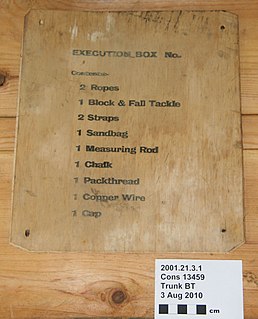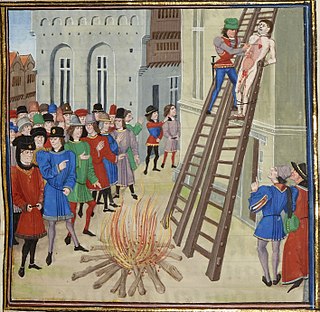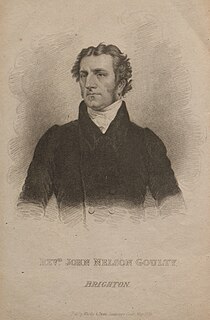Related Research Articles

Tyburn was a manor (estate) in the county of Middlesex, one of two which were served by the parish of Marylebone.

Newgate Prison was a prison at the corner of Newgate Street and Old Bailey Street just inside the City of London, England, originally at the site of Newgate, a gate in the Roman London Wall. Built in the 12th century and demolished in 1904, the prison was extended and rebuilt many times, and remained in use for over 700 years, from 1188 to 1902.

Hanging is the suspension of a person by a noose or ligature around the neck. The Oxford English Dictionary states that hanging in this sense is "specifically to put to death by suspension by the neck", though it formerly also referred to crucifixion and death by impalement in which the body would remain "hanging". Hanging has been a common method of capital punishment since medieval times, and is the primary execution method in numerous countries and regions. The first known account of execution by hanging was in Homer's Odyssey. In this specialised meaning of the common word hang, the past and past participle is hanged instead of hung.

Albert Pierrepoint was an English hangman who executed between 435 and 600 people in a 25-year career that ended in 1956. His father Henry and uncle Thomas were official hangmen before him.
Capital punishment in the United Kingdom predates the formation of the UK, having been used within the British Isles from ancient times until the second half of the 20th century. The last executions in the United Kingdom were by hanging, and took place in 1964; capital punishment for murder was suspended in 1965 and finally abolished in 1969. Although unused, the death penalty remained a legally defined punishment for certain offences such as treason until it was completely abolished in 1998; the last execution for treason took place in 1946. In 2004 the 13th Protocol to the European Convention on Human Rights became binding on the United Kingdom; it prohibits the restoration of the death penalty as long as the UK is a party to the convention.

William Marwood was a hangman for the British government. He developed the technique of hanging known as the "long drop".

A gibbet is any instrument of public execution. Gibbeting is the use of a gallows-type structure from which the dead or dying bodies of criminals were hanged on public display to deter other existing or potential criminals. Occasionally, the gibbet was also used as a method of execution, with the criminal being left to die of exposure, thirst and/or starvation. The practice of placing a criminal on display within a gibbet is also called "hanging in chains".

Jack Sheppard, or "Honest Jack", was a notorious English thief and prison escapee of early 18th-century London.

Capital punishment in New Zealand – the process of sentencing convicted offenders to death for the most serious crimes and carrying out that sentence, as ordered by a legal system – first appeared in a codified form when New Zealand became a British colony in 1840. It was first carried out with a public hanging in Victoria St, Auckland in 1842, while the last execution occurred in 1957 at Mount Eden Prison, also in Auckland. In total, 85 people have been executed in New Zealand.

Execution Dock was a place in the River Thames near the shoreline at Wapping, London, that was used for more than 400 years to execute pirates, smugglers and mutineers who had been sentenced to death by Admiralty courts. The "dock" consisted of a scaffold for hanging. Its last executions were in 1830.

A public execution is a form of capital punishment which "members of the general public may voluntarily attend." This definition excludes the presence of only a small number of witnesses called upon to assure executive accountability. The purpose of such displays has historically been to deter individuals from defying laws or authorities. Attendance at such events was historically encouraged and sometimes even mandatory.
Ada Chard Williams (1875–1900) was a baby farmer who was convicted of strangling to death 21-month-old Selina Ellen Jones in Barnes in London in September 1899.

William Calcraft was a 19th-century English hangman, one of the most prolific of British executioners. It is estimated in his 45-year career he carried out 450 executions. A cobbler by trade, Calcraft was initially recruited to flog juvenile offenders held in Newgate Prison. While selling meat pies on streets around the prison, Calcraft met the City of London's hangman, John Foxton.

To be hanged, drawn and quartered became a statutory penalty for men convicted of high treason in the Kingdom of England from 1352 under King Edward III (1327–1377), although similar rituals are recorded during the reign of King Henry III (1216–1272). The convicted traitor was fastened to a hurdle, or wooden panel, and drawn by horse to the place of execution, where he was then hanged, emasculated, disembowelled, beheaded, and quartered. His remains would then often be displayed in prominent places across the country, such as London Bridge, to serve as a warning of the fate of traitors. For reasons of public decency, women convicted of high treason were instead burned at the stake.

There are obvious inconsistencies between this article and James Botting, see talk page

The Capital Punishment Amendment Act 1868 received Royal Assent on 29 May 1868, putting an end to public executions for murder in the United Kingdom. The act required that all prisoners sentenced to death for murder be executed within the walls of the prison in which they were being held, and that their bodies be buried in the prison grounds. It was prompted at least in part by the efforts of reformers such as Sir Robert Peel and Charles Dickens, who called in the national press for an end to the "grotesque spectacle" of public executions. Abolition of public executions was one of the recommendations of the Royal Commission on Capital Punishment 1864-1866. A similar measure, the Capital Punishment within Prisons Bill, had been introduced in 1867, but failed for lack of parliamentary time.
James Pratt (1805–1835), also known as John Pratt, and John Smith (1795–1835) were two London men who, in November 1835, became the last two to be executed for sodomy in England. Pratt and Smith were arrested in August of that year after allegedly being spied through a keyhole having sex in the rented room of another man, William Bonill. Bonill, although not present, was transported to Australia as an accessory to the crime, where he died.

John Nelson Goulty was an English Nonconformist Christian pastor. He is best known for his sermons against mandatory tithing to the Church of England and against colonial slavery. After early work at Nonconformist chapels in Godalming and Henley-on-Thames, he moved to Brighton where he became "one of the most important persons" in the 300-year history of the town's Union Chapel. He also helped to found schools and a cemetery in Brighton.

In England, burning was a legal punishment inflicted on women found guilty of high treason, petty treason, and heresy. Over a period of several centuries, female convicts were publicly burnt at the stake, sometimes alive, for a range of activities including coining and mariticide.
References
- 1 2 3 Janet Cameron (2008). Brighton & Hove Murders & Misdemeanours. Amberley Publishing. p. 71. ISBN 978-1-84868-167-5.
- 1 2 John Laurence (1971). A history of capital punishment: with special reference to capital punishment in Great Britain. Kennikat Press. pp. 108–109. ISBN 0-8046-1114-9.
- 1 2 James Erredge (1862). History of Brighthelmstone. pp. 335–336.
- ↑ Horace Bleackley (1929). The hangmen of England: how they hanged and whom they hanged : the life story of "Jack Ketch" through two centuries. Taylor & Francis. p. 170. ISBN 0-7158-1184-3.